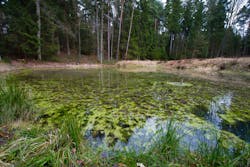Study shows how algal blooms can be rapidly predicted
RESTON, Va. — Dec. 10, 2015 — Scientists have identified factors that can help provide rapid predictions of harmful algal blooms in Ohio’s lakes, according to a press release.
These large growths of toxin-producing bacteria, which sometimes turn water green or blue-green, can be irritating to the skin and may affect the human liver and nervous system if consumed, noted the release. More up-to-date forecasts of when blooms are likely to appear in the lakes could help protect people who use them.
Scientists from the U.S. Geological Survey (USGS) and partners made real-time water-quality and environmental measurements at seven recreational areas in Ohio during May-November in 2013 and 2014, reported the release. Their goal was to identify factors that could be used in models to quickly predict levels of microcystin, the most commonly detected toxin found in freshwater algal blooms, and provide advisories to swimmers and boaters.
“Algal bloom toxins in water are currently measured in the laboratory, and results take time,” explained Donna Francy, lead USGS scientist for the study, in the release. “Utilizing nowcasts to determine when and where a bloom may occur in real-time can better protect people like swimmers and boaters that use and consume water resources.”
Models are already used at Lake Erie beaches as part of the Ohio Nowcast for predicting E. coli concentrations, shared the release.
“The Ohio Nowcast system for E. coli, operating since 2006, is similar to a weather forecast except that current water-quality conditions instead of future conditions are estimated,” said Francy in the release. “Since a nowcast has worked for E. coli, we decided to try to develop one for cyanoHABs (cyanobacterial harmful algal blooms) and their associated toxins.”
After collecting weekly to monthly data for two recreational seasons, the scientists identified factors that could be used to predict microcystin concentrations at a variety of freshwater sites, stated the release. Results showed that measurements of a pigment called phycocyanin, water clarity, water pH, streamflow from a nearby river and lake level changes over 24 hours were among the best factors to estimate microcystin levels in real-time.
Future studies will focus on collecting more frequent data so that the scientists can develop site-specific models to use in cyanoHAB nowcasts, noted the release.
You can find the entire release here.
